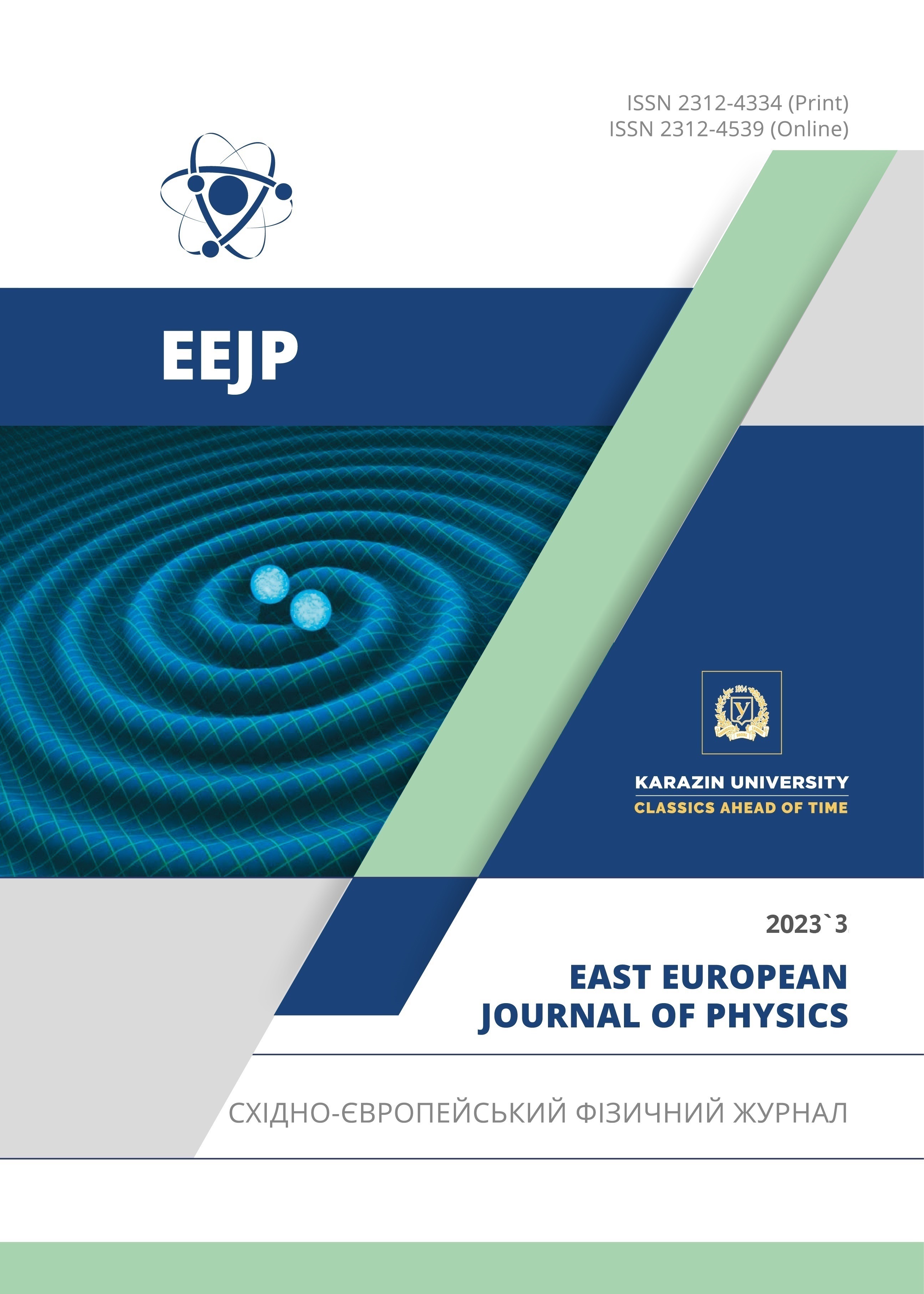Chaos Synchronization of InGaAsP Lasers
Abstract
The optical output of a semiconductor laser can fluctuate chaotically by modulating its direct current in limited conditions of the modulated current signal parameters in terms of modulation frequency and modulation index. In this work, single, double, and chaotic pulses of an InGaAsP laser with direct current modulation, are numerically presented through a bifurcation diagram. Numerically, the unidirectional optical coupling system realizes chaotic synchronization between two identical InGaAsP lasers with direct current modulation, as the transmitter/receiver configuration. The transmission time for transmitting light from the transmitted laser to the received laser is essential for controlling the quality of chaos synchronization. The transmission time applies on the order of nanoseconds. Chaos synchronization quality is estimated by a correlation plot and calculated by the cross-correlation coefficient. This study observed the best synchronization quality (complete chaos synchronization) when the two lasers are identical. On the other hand, the chaotic synchronization between two non-identical InGaAsP lasers was investigated. In this case, complete chaos synchronization is not found, and the quality of chaotic synchronization was observed to decrease as the mismatch between the parameters of the two lasers increased.
Downloads
References
L. M. Pecora, and T. L. Carroll, Physical review letters 64, 821(1990).
L. Kocarev, and U. Parlitz, Physical review letters 74, 5028(1995).
H. D. Abarbanel, and M. B. Kennel, Physical review letters 80, 3153(1998).
S. F.Abdalah, F. T. Arecchi, F. Marino, K. Al-Naimee, Ciszak M., and R. Meucci, “Optoelectronic feedback in semiconductor light sources: optimization of network components for synchronization, ” chapter 29, 651-660 (2011).
G. Yuan, X. Zhang, and Z. Wang, Optik 125, 1950-1953(2014).
J. Yang, and F. Zhu, Communications in Nonlinear Science and Numerical Simulation 18, 926-937(2013)
S. Moon, J. J. Baik, and J. M. Seo, Communications in Nonlinear Science and Numerical Simulation 96, 105708(2021).
C. R[1] L.M. Pecora, and T.L. Carroll, Physical review letters, 64, 821 (1990). https://doi.org/10.1103/PhysRevLett.64.821
L. Kocarev, and U. Parlitz, Physical review letters, 74, 5028 (1995). https://doi.org/10.1103/PhysRevLett.74.5028
H.D. Abarbanel, and M.B. Kennel, Physical review letters, 80, 3153 (1998). https://doi.org/10.1103/PhysRevLett.80.3153
S.F. Abdalah, F.T. Arecchi, F. Marino, K. Al-Naimee, M. Ciszak, and R. Meucci, in: Optoelectronic Devices and Properties, edited by O. Sergiyenko, (InTech, 2011), pp. 651-660. https://doi.org/10.5772/14197
G. Yuan, X. Zhang, and Z. Wang, Optik, 125, 1950 (2014). https://doi.org/10.1016/j.ijleo.2013.11.007
J. Yang, and F. Zhu, Communications in Nonlinear Science and Numerical Simulation, 18, 926-937 (2013). https://doi.org/10.1016/j.cnsns.2012.09.009
S. Moon, J.J. Baik, and J.M. Seo, Communications in Nonlinear Science and Numerical Simulation, 96, 105708 (2021). https://doi.org/10.1016/j.cnsns.2021.105708
C.R. Mirasso, P. Colet, and P. García-Fernández, IEEE Photonics Technology Letters, 8, 299 (1996). https://doi.org/10.1109/68.484273
A. Sanchez-Diaz, C.R. Mirasso, P. Colet, and P. Garcia-Fernandez, IEEE journal of quantum electronics, 35, 292 (1999). https://doi.org/10.1109/3.748833
H.F. Chen, and J.M. Liu, IEEE journal of quantum electronics, 36, 27 (2000). https://doi.org/10.1109/3.817635
J.M. Liu, H.F. Chen, and S. Tang, IEEE Transactions on Circuits and Systems I: Fundamental Theory and Applications, 48, 1475 (2001). https://doi.org/10.1109/TCSI.2001.972854
S. Tang, and J.M. Liu, Optics letters, 26, 596 (2001). https://doi.org/10.1364/OL.26.000596
S. Tang, H.F. Chen, S.K. Hwang, and J.M. Liu, IEEE Transactions on Circuits and Systems I: Fundamental Theory and Applications, 49, 163 (2002). https://doi.org/10.1109/81.983864
N. Jiang, A. Zhao, S. Liu, C. Xue, and K. Qiu, Optics express, 26, 32404 (2018). https://doi.org/10.1364/oe.26.032404
A. Murakami, and J. Ohtsubo, Physical Review A, 65, 033826 (2002). https://doi.org/10.1103/PhysRevA.65.033826
E.M. Shahverdiev, and K.A. Shore, Optics Communications, 282, 3568 (2009). https://doi.org/10.1016/j.optcom.2009.05.068
I. Oowada, H. Ariizumi, M. Li, S. Yoshimori, A. Uchida, K. Yoshimura, and P. Davis, Optics express, 17, 10025-10034 (2009). https://doi.org/10.1364/OE.17.010025
L. Yu-Jin, Z. Sheng-Hai, and Q. Xing-Zhong, Chinese Physics, 16, 463 (2007). https://doi.org/10.1088/1009-1963/16/2/029
S. Tang, and J.M. Liu, IEEE journal of quantum electronics, 39, 708 (2003). https://doi.org/10.1109/JQE.2003.810775
M.H. Al-Lamye, and B.A. Ghalib, “High quality of generalized chaos synchronization in quantum-dot laser diode,” AIP Conference Proceedings, 2386, 080005 (2022). https://doi.org/10.1063/5.0066864
Y. C. Kouomou, and P. Woafo, Optics communications, 223, 283 (2003). https://doi.org/10.1016/S0030-4018(03)01683-3
S.T. Kingni, C. Ainamon, V. Kamdoum, and J.C. Orou, Chaos Theory and Applications, 2, 31-39 (2020). https://dergipark.org.tr/en/download/article-file/1154899
O. Junji, Semiconductor lasers: stability, instability and chaos, (Springer, 2017).
Y. Hori, H. Serizawa, and H. Sato, JOSA B, 5, 1128 (1988). https://doi.org/10.1364/JOSAB.5.001128
E. Hemery, L. Chusseau, and J.M. Lourtioz, IEEE journal of quantum electronics, 26, 633 (1990). https://doi.org/10.1109/3.53379
S. Bennett, C.M. Snowden, and S. Iezekiel, (1995). “Chaos in directly modulated laser diodes under two-tone modulation,” in: LEOS '95. IEEE Lasers and Electro-Optics Society 1995 Annual Meeting. 8th Annual Meeting. Conference Proceedings, 2, pp. 143-144, (1995). https://doi.org/10.1109/LEOS.1995.484637
S. Bennett, C.M. Snowden, and S. Iezekiel, IEEE journal of quantum electronics, 33, 2076 (1997). https://doi.org/10.1109/3.641323
G. Carpintero, and H. Lamela, Journal of applied physics, 82, 2766 (1997). https://doi.org/10.1063/1.366108
C.H. Lee, T.H. Yoon, and S.Y. Shin, Applied Physics Letters, 46, 95 (1985). https://doi.org/10.1063/1.95810
G.P. Agrawal, Applied physics letters, 49, 1013 (1986). https://doi.org/10.1063/1.97456
M. Tang, and S. Wang, Applied physics letters, 48, 900 (1986). https://doi.org/10.1063/1.96652
R.J. Jones, P. Rees, P.S. Spencer, and K.A. Shore, JOSA B, 18, 166-172 (2001). https://doi.org/10.1364/JOSAB.18.000166
Copyright (c) 2023 Mohammed H.H. Al-Jassani, Aqeel I. Faris, Hussein H. Khudhur

This work is licensed under a Creative Commons Attribution 4.0 International License.
Authors who publish with this journal agree to the following terms:
- Authors retain copyright and grant the journal right of first publication with the work simultaneously licensed under a Creative Commons Attribution License that allows others to share the work with an acknowledgment of the work's authorship and initial publication in this journal.
- Authors are able to enter into separate, additional contractual arrangements for the non-exclusive distribution of the journal's published version of the work (e.g., post it to an institutional repository or publish it in a book), with an acknowledgment of its initial publication in this journal.
- Authors are permitted and encouraged to post their work online (e.g., in institutional repositories or on their website) prior to and during the submission process, as it can lead to productive exchanges, as well as earlier and greater citation of published work (See The Effect of Open Access).








